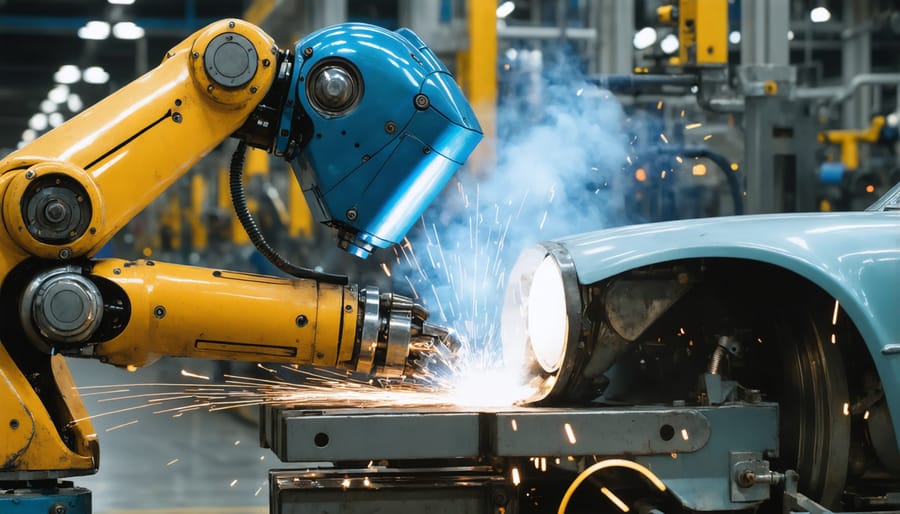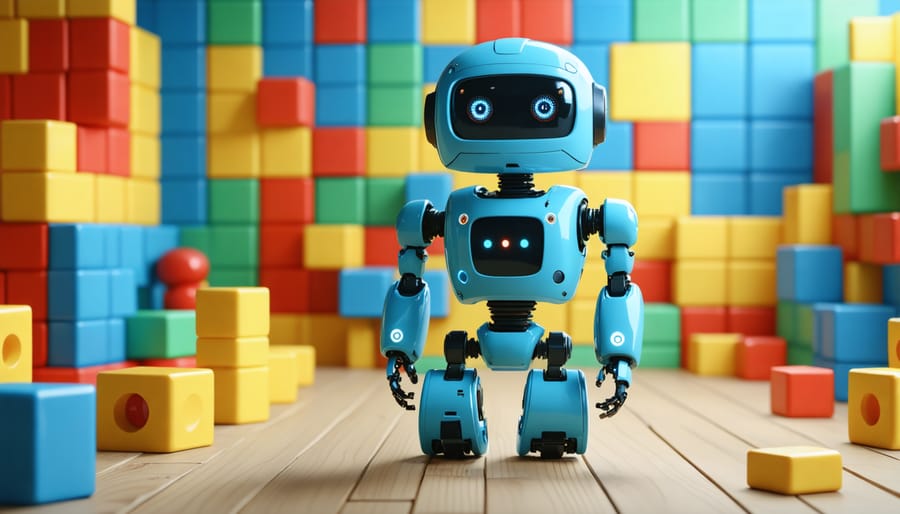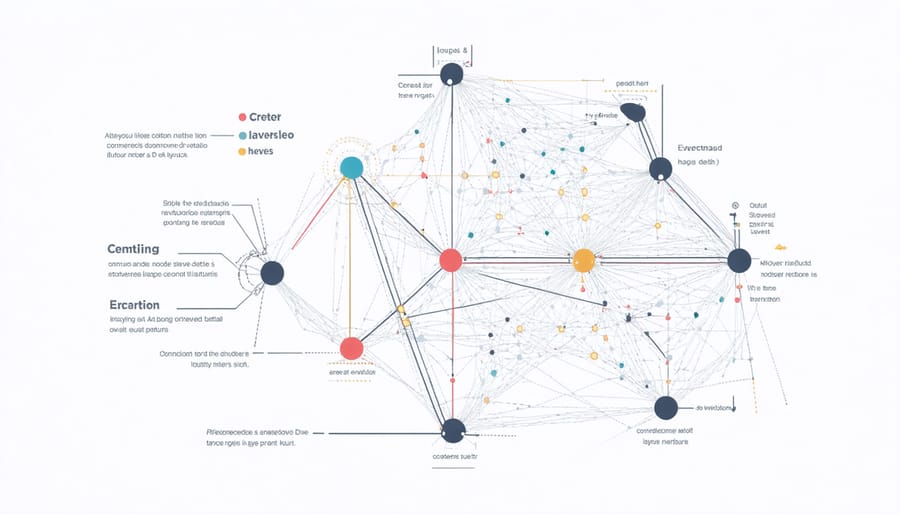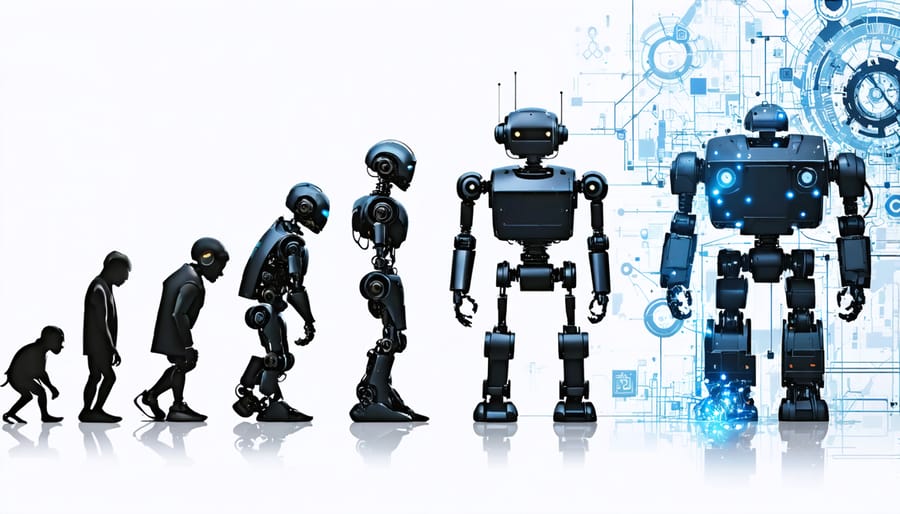From industrial workhorses to sophisticated learning machines, robots have revolutionized our world and laid the foundation for modern artificial intelligence. The journey from simple automated arms to today’s intelligent machines showcases how early AI breakthroughs transformed manufacturing, exploration, and human-machine interaction. These five distinct robot categories represent crucial evolutionary steps in automation technology, each contributing unique capabilities that continue to shape our technological landscape. Whether performing precise surgical procedures or exploring distant planets, these mechanical marvels demonstrate the remarkable progression from basic programmed movements to adaptive, intelligent systems. Understanding their development provides essential context for grasping current AI innovations and glimpsing the future of human-robot collaboration.
Industrial Manipulator Robots
The Unimate Revolution
In 1961, a groundbreaking innovation changed the face of manufacturing forever: the Unimate, the world’s first industrial robot. Created by George Devol and Joseph Engelberger, this mechanical arm revolutionized assembly line production at General Motors, marking the birth of industrial robotics. The Unimate could perform repetitive tasks with unprecedented precision, replacing human workers in dangerous and monotonous jobs.
This pioneering robot laid the foundation for modern automation and sparked intense interest in artificial intelligence development. Its success demonstrated that machines could reliably execute complex sequences of movements, leading to rapid advancements in robot programming and control systems. The Unimate’s impact extended far beyond the factory floor, inspiring researchers to explore more sophisticated robot applications.
Today’s collaborative robots and smart manufacturing systems can trace their lineage back to this revolutionary invention, which proved that robots could work safely alongside humans while boosting productivity and workplace safety. The Unimate’s legacy continues to influence how we approach human-robot interaction and industrial automation.

Early Programming Challenges
The emergence of industrial robots in the 1960s presented unique programming challenges that significantly shaped early AI programming methods. Engineers faced the complex task of teaching machines to perform precise, repetitive tasks while adapting to slight variations in their environment. These challenges led to the development of fundamental programming concepts still used today, such as pattern recognition and basic decision trees.
The UNIMATE robot, installed at General Motors in 1961, required programmers to devise ways for machines to understand spatial relationships and coordinate movement sequences. This pushed the boundaries of existing computer science, leading to innovations in motion planning algorithms and control systems. The solutions created for these early industrial robots laid the groundwork for more sophisticated AI applications, including modern autonomous systems and smart manufacturing platforms.
These pioneering efforts also revealed the importance of human-machine interfaces, prompting the development of more intuitive programming languages and teaching methods for robots.
Mobile Research Robots
Shakey: The First AI Navigator
In 1969, a groundbreaking robot named Shakey made history at Stanford Research Institute as the first mobile robot to combine logical reasoning with physical actions. Standing at 6 feet tall and equipped with a TV camera, range finder, and bump sensors, Shakey could perceive its environment and make decisions based on what it “saw.”
What made Shakey truly revolutionary was its ability to break down complex commands into simpler tasks. If asked to move a box from one room to another, it would first plan a route, navigate around obstacles, and adjust its actions based on unexpected changes in its environment. This pioneering achievement laid the foundation for modern autonomous navigation systems.
Shakey’s software architecture introduced several fundamental concepts still used in robotics today, including the A* search algorithm and the STRIPS planner. Despite its slow movement (which earned it the nickname “Shakey”), the robot demonstrated that machines could use artificial intelligence to understand and interact with their surroundings.
The legacy of Shakey continues to influence modern robotics, from warehouse automation to self-driving cars, proving that sometimes the shakiest beginnings can lead to the most stable foundations in technological advancement.

Stanford Cart’s Legacy
The Stanford Cart, developed in the 1960s, revolutionized autonomous navigation and laid the groundwork for modern self-driving vehicles. This early mobile robot used a basic camera system to perceive its environment and navigate around obstacles, marking one of the first successful demonstrations of computer vision in robotics.
Its legacy lives on in today’s autonomous systems, from warehouse robots to self-driving cars. The Cart’s pioneering work in visual navigation helped establish fundamental principles that engineers still use, such as real-time image processing and obstacle avoidance algorithms. While the original Cart moved at a snail’s pace, taking 10-15 minutes between movements to process images, it proved that machines could make independent navigation decisions based on visual input.
The project’s success sparked research into more sophisticated sensor systems and faster processing methods. Modern autonomous vehicles now use advanced versions of the Cart’s basic principles, combining multiple sensors, GPS, and artificial intelligence to navigate complex environments in real-time. This evolution from the Stanford Cart’s simple camera system to today’s sophisticated autonomous navigation showcases how foundational innovations continue to shape cutting-edge technology.
Expert System Robots
DENDRAL’s Problem-Solving Approach
DENDRAL, developed at Stanford University in the 1960s, revolutionized how machines approach problem-solving. As the first expert system, it laid the groundwork for modern AI decision-making by analyzing chemical compounds and determining their molecular structure. What made DENDRAL groundbreaking was its ability to mimic human expert reasoning through a systematic approach called the “generate and test” method.
The system worked by first generating possible solutions based on chemical analysis data, then testing each possibility against known rules and constraints. This methodical process helped eliminate incorrect solutions while identifying the most likely molecular structures. DENDRAL’s success proved that computers could handle complex problem-solving tasks previously thought possible only for human experts.
Its influence extends far beyond chemistry, inspiring numerous expert systems in medicine, engineering, and robotics. Modern robots still use similar decision-making frameworks, demonstrating how this early innovation continues to shape AI development today.
From Rules to Learning
The evolution from rule-based robots to learning systems marks a revolutionary shift in robotics. Early robots relied on fixed programming, following strict if-then rules to perform specific tasks. While effective for repetitive jobs like assembly lines, these systems couldn’t adapt to new situations or learn from experience.
The breakthrough came with the integration of machine learning algorithms, enabling robots to learn from data and improve their performance over time. Instead of being explicitly programmed for every scenario, modern robots can recognize patterns, make decisions, and even learn from their mistakes.
This transition has led to robots that can navigate complex environments, interact naturally with humans, and tackle unpredictable situations. For example, warehouse robots now learn optimal picking routes through experience, while collaborative robots in manufacturing can adjust their movements based on working alongside different human colleagues.
The shift from rules to learning has opened new possibilities in robotics, from self-driving cars to sophisticated healthcare assistants, fundamentally changing how we think about robot capabilities.
Social Interaction Robots
ELIZA’s Conversational Impact
ELIZA, created by Joseph Weizenbaum in 1966, revolutionized human-computer interaction by becoming the first chatbot to engage in meaningful conversations. This groundbreaking program used pattern matching and simple rules to simulate a psychotherapist, responding to users with questions that gave the illusion of understanding and empathy. Despite its basic functionality, ELIZA demonstrated how machines could engage in natural language processing and laid the foundation for modern AI assistants.
The program’s success showed that even simple algorithmic responses could create compelling interactions, leading to what became known as the “ELIZA effect” – where humans attribute human-like characteristics to computer programs. This discovery influenced the development of subsequent chatbots and virtual assistants, from early experiments to today’s sophisticated AI systems like Siri and Alexa.
ELIZA’s legacy continues to shape how we design conversational AI, emphasizing the importance of natural dialogue and user engagement in human-computer interactions.
Building Robot Empathy
Modern robots are increasingly being designed with emotional intelligence capabilities, allowing them to recognize and respond to human emotions. This development marks a significant shift from purely mechanical interactions to more nuanced, empathetic exchanges. Engineers achieve this by incorporating advanced facial recognition systems, voice analysis tools, and gesture detection algorithms that help robots interpret human emotional states.
These emotionally aware robots are particularly valuable in healthcare and elderly care settings, where they can provide companionship and emotional support. For example, therapeutic robots like PARO, a seal-like companion robot, can respond to touch and voice, adjusting their behavior based on the user’s emotional state. In educational environments, robots with emotional recognition capabilities help create more engaging learning experiences by adapting their teaching style to students’ emotional responses.
The technology continues to evolve, with researchers working on more sophisticated systems that can detect subtle emotional cues and respond with appropriate gestures, expressions, and verbal responses, making human-robot interactions increasingly natural and meaningful.
Learning Robots
Neural Network Pioneers
In the late 1980s, researchers made a breakthrough by developing robots that could use neural networks for learning and adapting to their environment. The ALVINN (Autonomous Land Vehicle In a Neural Network) project at Carnegie Mellon University marked a significant milestone, creating one of the first self-driving vehicles that learned from human demonstrations. These pioneering robots could recognize patterns, make decisions, and improve their performance through experience – capabilities that were previously thought impossible. The success of these early neural network-based robots laid the foundation for modern machine learning systems and inspired the development of more sophisticated AI-powered robots that we see today in applications ranging from manufacturing to healthcare.

Adaptive Behaviors
In the early days of robotics, scientists began experimenting with robots that could learn from their experiences, marking a significant shift from purely programmed behaviors. One of the first breakthroughs came in the 1970s with the Stanford Cart, which could navigate around obstacles by learning from its previous attempts. This was followed by the development of robots that could adjust their movements based on sensor feedback, much like how humans learn through trial and error.
These early adaptive systems laid the groundwork for modern machine learning in robotics. For example, the WABOT-1, developed in 1973, could perform basic pattern recognition and modify its responses based on environmental input. Similarly, the MIT Leg Laboratory’s hopping robots in the 1980s demonstrated how machines could adapt their movements to maintain balance on uneven surfaces.
These pioneering efforts, though limited by the technology of their time, established the fundamental principles that would later enable more sophisticated learning algorithms and autonomous systems.
These five pioneering robots laid the foundation for today’s artificial intelligence landscape, demonstrating how mechanical innovation can evolve into cognitive computing. From the precise movements of industrial arms to the adaptive learning capabilities of later models, each robot type contributed unique elements to modern AI development. Their successes and limitations helped shape our understanding of machine learning, computer vision, and autonomous decision-making. As we look toward the future, these early innovations continue to influence the development of more sophisticated AI systems, from self-driving cars to healthcare robots. Their legacy reminds us that the journey from simple automated tasks to complex artificial intelligence is an ongoing evolution, with each breakthrough building upon previous achievements. The lessons learned from these early robots remain relevant as we tackle new challenges in AI development, making them an essential part of our technological heritage.

